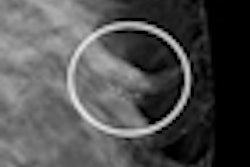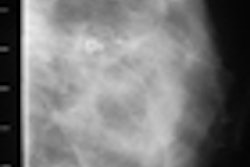The "harms" of mammography screening -- widely cited as justification for raising the mammography screening age in the U.S. -- just aren't that harmful, according to a presentation this week at the Society of Breast Imaging (SBI) meeting in San Antonio.
In a session given Wednesday morning, Dr. Michael Linver, from X-Ray Associates of New Mexico, outlined the relative risk of screening mammography for session attendees, in direct response to the harms cited by the U.S. Preventive Services Task Force (USPSTF) as evidence for their 2009 guidance that raised the recommended age to begin mammography screening.
"There are risks to screening for breast cancer, just as there are in any other test in medicine," Linver said. "These cannot be trivialized, but they pale when compared to the real harm of not screening."
According to the USPSTF, harms of screening women between the ages of 40 and 49 include physical and psychological harms, additional imaging and biopsies, overdiagnosis, and radiation exposure, Linver said. He addressed each of these in turn.
Good compression for a mammography screening exam can cause some pain, he said: Studies show 1% to 77% of women report pain from the exam. But few consider this discomfort a deterrent from further screening mammography. And a woman's pain at screening can be minimized by timing the mammogram properly with her menstrual cycle and educating women on ways to reduce stress before they come in to have the exam.
Concerning psychological pain, it is usually transient and also does not pose a barrier to screening. If a woman is given negative results clearly, her anxiety can be minimized, according to Linver.
Besides, the idea that pain equals harm is a faulty one, he said.
"There are other causes of pain from experiences that we still consider necessary," Linver said. "Visiting the dentist, getting a flu shot, having a biopsy. But we don't say that these things should be avoided just because there's some pain involved."
As for the idea that one of screening mammography's harms is additional tests and biopsies in patients who do not have breast cancer, it's an acceptable trade, Linver said.
"The probability of a false-positive examination is between 0.9% and 6.5%," he said. "The 10-year likelihood of false-positive exams is 21% to 49%. But most women consider these a reasonable trade-off, if 500 or more false positives result in one life saved."
On average, women between the ages of 40 and 49 who have annual screening mammograms will have a false-positive test every 10 years, be recalled for additional imaging every 12 years, and undergo a false-positive biopsy once every 149 years, according to Linver.
Overdiagnosis and radiation exposure
Linver also addressed the issue of "overdiagnosis," which he defined as the diagnosis and treatment of breast cancers that might never become apparent during a woman's lifetime, or unnecessary early diagnosis and treatment of cancer that would have been identified but would not have been fatal.
Overdiagnosis is greatest at a first screening exam, when 37% of ductal carcinoma in situ (DCIS) has been found to be nonprogressive. But the overdiagnosis rate drops dramatically -- to 4% -- for new or enlarging findings on subsequent annual screenings, Linver said. Overall, for every 11 cancers diagnosed by screening mammography, two are life-saving and one is an overdiagnosis.
In terms of radiation exposure, the USPSTF estimated that women ages 40 to 49 getting annual mammograms would receive 60 mGy of radiation over 10 years of screening. But this was incorrect, Linver said: The task force combined mean glandular dose to both breasts.
"The correct mean glandular dose for full-field digital mammography is 3.7 mGy" per exam, he told session attendees. "This translates to a fatal radiation-induced cancer rate for women in this age group of one in 10,000, compared to the one in 51 chance of developing invasive breast cancer or DCIS during this age range."
If U.S. women ages 30 to 39 today followed the USPSTF 2009 guidelines when they came of screening age, rather than the American Cancer Society's recommendation of starting at 40, nearly 100,000 more women in this cohort would die of breast cancer between the ages of 40 and 84, Linver concluded.
"Early and tragic death from advanced breast cancer would seem a greater harm than all the other 'harms' combined," he said.




















